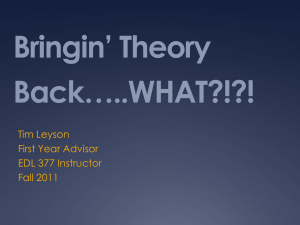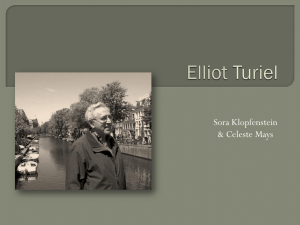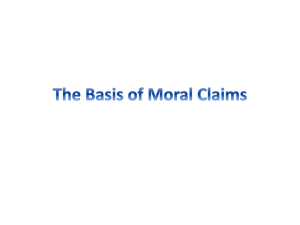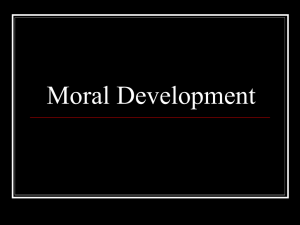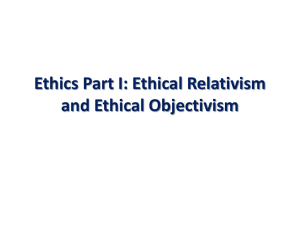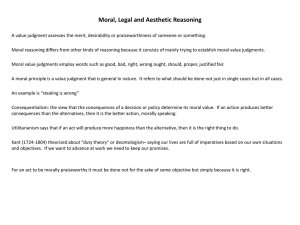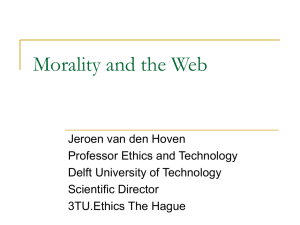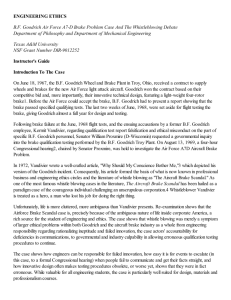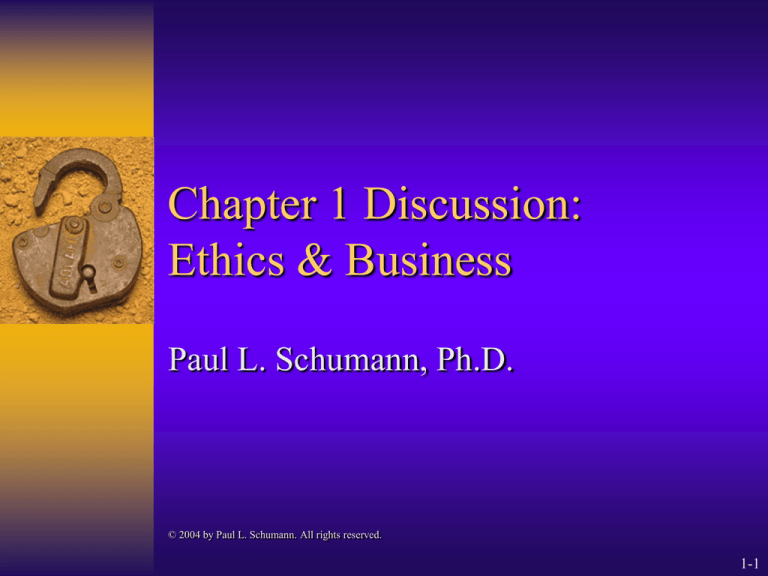
Chapter 1 Discussion:
Ethics & Business
Paul L. Schumann, Ph.D.
© 2004 by Paul L. Schumann. All rights reserved.
1-1
Introduction
What did Merck do to deal with the disease
“river blindness”?
Why did Merck invest so much money and
effort into a drug that made no money?
1-2
Nature of Business Ethics
What does “ethical” mean to you?
How does Velasquez define “morality”?
What are the five characteristics that
distinguish moral standards from other
standards?
How does Velasquez define “ethics”?
How does Velasquez define “business
ethics”?
1-3
Nature of Business Ethics
To whom should moral standards apply:
Should a company be morally responsible for
its actions? Why?
Should the managers involved be morally
responsible for the actions they take in the
name of a company? Why?
Should both a company and its managers be
morally responsible? Why?
1-4
Nature of Business Ethics
In what ways do the following issues
involving multinational companies raise
ethical issues?
Shift operations to a country with cheaper labor
and less government regulation.
Transfer materials and money between
countries to escape paying taxes.
Transfer products to countries that aren’t ready
for the technology.
Different nations have different standards.
1-5
Nature of Business Ethics
What is the theory of “ethical relativism”?
Are there some moral standards that a society
must accept if it is to survive? Examples?
Do apparent differences in moral standards
across different societies sometimes disappear
on closer examination? Examples?
If two people disagree on moral standards, does
that mean they both have to be right? Explain?
What are some examples of incoherent
consequences of the theory of ethical
relativism?
1-6
Nature of Business Ethics
Is it ethical for someone who believes in
ethical relativism to impose their ethical
relativism morality on others who disagree
with ethical relativism? Explain?
1-7
Moral Development
According to Kohlberg, what is Stage One
of moral development?
“The only crime is getting caught.” How is this
an example of Stage One thinking?
Give an example of Stage One thinking.
Give an example of employee behavior in a
business that illustrates Stage One thinking.
As managers, how can we motivate a Stage
One employee to act ethically?
1-8
Moral Development
According to Kohlberg, what is Stage Two
of moral development?
“You scratch my back and I’ll scratch yours.”
How is this an example of Stage Two thinking?
Give an example of Stage Two thinking.
Give an example of employee behavior in a
business that illustrates Stage Two thinking.
As managers, how can we motivate a Stage
Two employee to act ethically?
1-9
Moral Development
According to Kohlberg, what is Stage Three
of moral development?
Give an example of Stage Three thinking.
Give an example of employee behavior in a
business that illustrates Stage Three thinking.
As managers, how can we motivate a Stage
Three employee to act ethically?
1-10
Moral Development
According to Kohlberg, what is Stage Four
of moral development?
Give an example of Stage Four thinking.
Give an example of employee behavior in a
business that illustrates Stage Four thinking.
As managers, how can we motivate a Stage
Four employee to act ethically?
1-11
Moral Development
According to Kohlberg, what is Stage Five
of moral development?
Give an example of Stage Five thinking.
Give an example of employee behavior in a
business that illustrates Stage Five thinking.
As managers, how can we motivate a Stage
Five employee to act ethically?
1-12
Moral Development
According to Kohlberg, what is Stage Six of
moral development?
Give an example of Stage Six thinking.
Give an example of employee behavior in a
business that illustrates Stage Six thinking.
As managers, how can we motivate a Stage Six
employee to act ethically?
1-13
Moral Development
According to research by Kohlberg and
others, does everyone progress through all
the stages? Explain.
In what ways are higher stages “better” than
lower stages?
How has Carol Gilligan criticized
Kohlberg?
What does the research show about Gilligan’s
ideas?
1-14
For & Against Business Ethics
Velasquez argues that “…ethical behavior is
the best long-term business strategy for a
company…” (p. 5). Do you agree or
disagree? Why? Examples?
1-15
Moral Responsibility
What are the two excusing conditions that
can completely eliminate a person’s moral
responsibility?
Why is ignorance an excusing condition?
• What if a person chooses to be ignorant?
• What if the person is ignorant because of
negligence?
Why is inability an excusing condition?
1-16
Moral Responsibility
Your boss orders you to do something
unethical. Should you be able to reduce
your moral responsibility because you were
just “following orders”?
Murder a competitor?
Do you have a moral obligation as an employee
to obey the immoral orders of your boss?
1-17
Case: The Air Force Brake
Cast of characters:
John Warren: engineer who designed brake,
short-tempered when challenged
Searle Lawson: 26, engineer grad 1 year ago
Kermit Vandivier: lab asst, 42, married, 7 kids
Robert Sink: Warren’s boss, project manager,
not engineer, HS degree, started as draftsman
Richard Gloor: test engineer
Russell Van Horn: Sink’s boss
Russell Line: senior executive
1-18
Case: The Air Force Brake
What were the 2 key reasons why Goodrich
won the bid to make the A7D brakes?
Why did Goodrich make an “absurdly low”
bid?
How was the brake design to be tested?
Why did the brake design fail the tests?
What happened when the brakes repeatedly
failed the tests?
1-19
Case: The Air Force Brake
Who might be affected by what happens?
What moral issues did Kermit Vandivier
face?
What choices did Kermit Vandivier have
when he was ordered to write a false report?
What are the pros and cons of each choice?
1-20
Case: The Air Force Brake
Is it morally right for a person in
Vandivier’s situation to write a false report?
Why?
What moral standards can we develop to guide
our moral judgment?
What is the consistency requirement for moral
standards?
Do the moral standards meet the consistency
requirement?
1-21
Case: The Air Force Brake
In terms of Kohlberg’s stages of moral
development, at which stage is:
Searle Lawson? Why?
Kermit Vandivier? Why?
1-22
Case: The Air Force Brake
Additional facts:
After Goodrich submitted the false report, the
Air Force began flight tests.
Several near crashes during landings:
• When the brakes were applied on landing, the
wheels would lock, causing the plane to skid 1500
feet down the runway.
1-23
Case: The Air Force Brake
Who should be morally responsible for any
“accidents” caused by the brakes?
Kermit Vandivier? Why?
Searle Lawson? Why?
John Warren? Why?
Robert Sink? Why?
Russell Line? Why?
Goodrich as a company? Why?
1-24
Case: The Air Force Brake
Should anyone’s moral responsibility be
reduced due to the ignorance or inability
excuses?
Kermit Vandivier? Why?
Searle Lawson? Why?
John Warren? Why?
Robert Sink? Why?
Russell Line? Why?
Goodrich as a company? Why?
1-25
Case: The Air Force Brake
Additional facts:
Vandivier went to a lawyer, then FBI.
Lawson went to a lawyer, then FBI.
Air Force began investigation.
Vandivier resigned from Goodrich.
1-26
Case: The Air Force Brake
Additional facts:
US Senate held hearings.
• Vandivier testified.
• Lawson’s testimony supported Vandivier’s.
• Sink and others denied wrongdoing.
– Vandivier dismissed as a high school grad with no
technical training.
– Lawson dismissed as young and inexperienced.
1-27
Case: The Air Force Brake
Additional facts:
Vandivier became a newspaper reporter.
Lawson became an engineer for LTV.
Warren kept his job.
Line was promoted.
Sink was promoted to Line’s job.
What lessons can be learned from this case?
1-28


